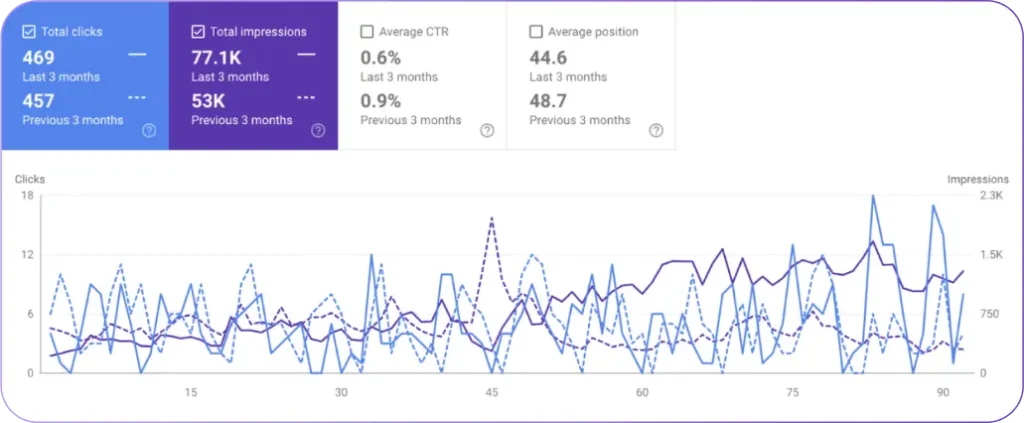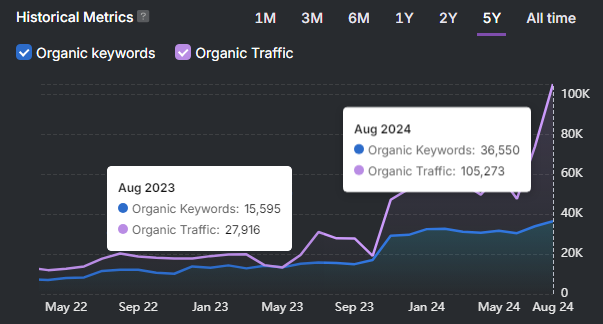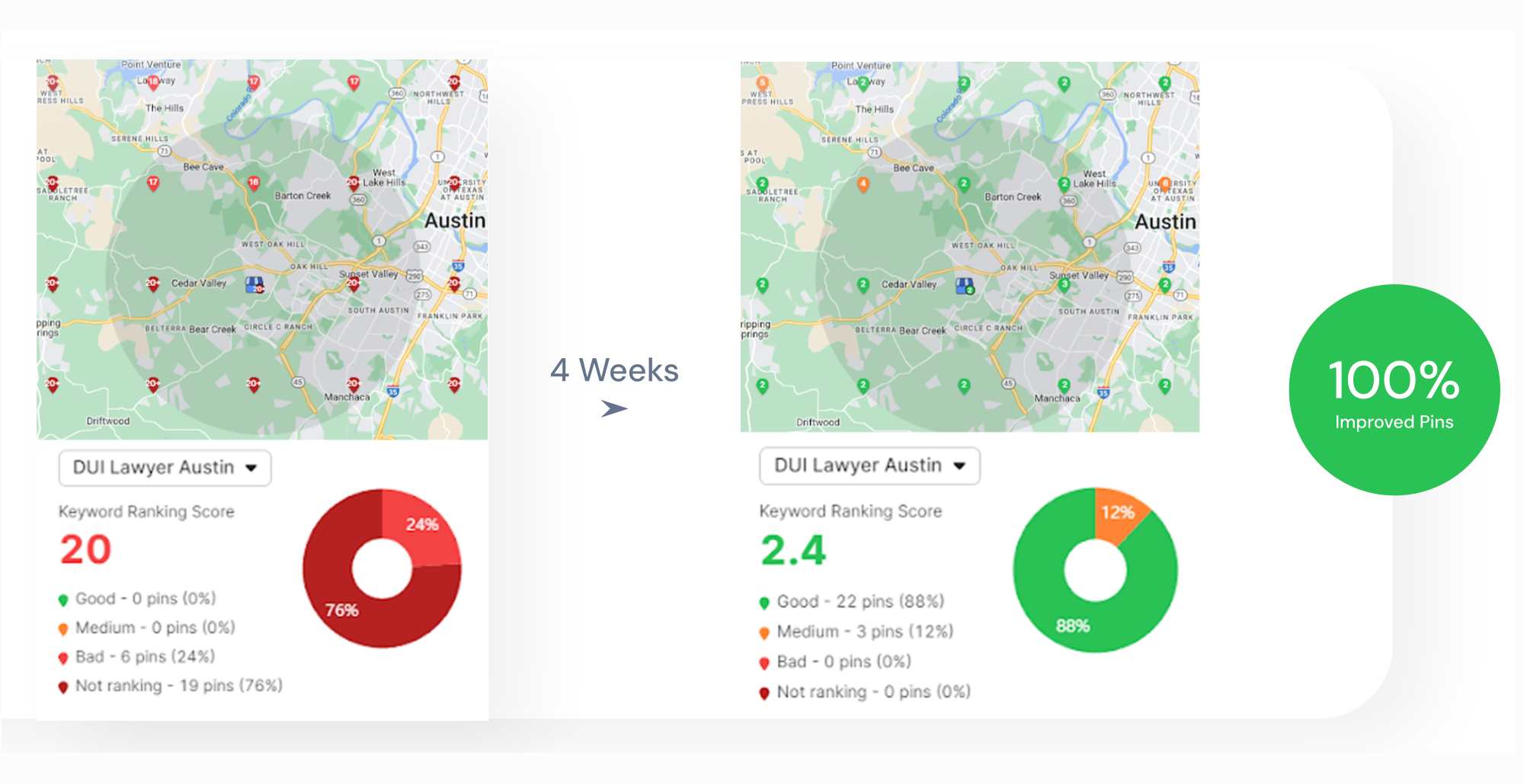SE Ranking is an SEO tool aimed at helping businesses, digital marketers, and agencies optimize their online presence. SE Ranking offers a standard suite of features to allow users to monitor keyword performance, identify technical issues, and analyze competitors’ backlink profiles. The main features of SE Ranking are the Rank Tracker, On-Page SEO Checker, and Website Audit.
SE Ranking’s prices start on the lower end of the spectrum, but some users have noted that costs can increase significantly depending on keyword volume, tracking frequency, and add-ons like the Content Editor or Local Marketing Tool. A main pro of SE Ranking is its user-friendly interface. A main con of SE Ranking is its data inaccuracy, particularly with regard to rank tracking. This SE Ranking SEO software review will cover the platform’s core features, pricing structure, pros and cons, and common user concerns to help you determine whether SE Ranking is a suitable fit for your SEO needs.
What is SE Ranking?
SE Ranking is an all-in-one SEO and digital marketing platform that provides a broad range of tools aimed at helping users manage and improve their online visibility. SE Ranking includes features for keyword tracking, site audits, backlink monitoring, competitor research, and on-page SEO analysis. The SE Ranking Tool is designed to support SEO workflows across different user types.
The SE Ranking platform allows users to track keyword rankings across locations and devices, conduct technical audits to identify site issues, and review backlink profiles for both their own domains and competitors. However, the depth of analysis in some SE Ranking tools may not meet the requirements of more advanced or specialized SEO operations. Additionally, the SE Ranking dashboard includes competitor research features that provide a general overview of rival keyword rankings, estimated traffic, and backlink sources. These insights can be useful for benchmarking, but users seeking highly detailed or specialized data may find the analysis less comprehensive than other tools.
The SE Ranking Tool offers flexibility through its tiered pricing. Still, the SE Ranking platform’s integrations, such as those with Google Analytics and Search Console, are fairly standard and may not satisfy users looking for more extensive API or third-party connections.
What is the History of SE Ranking?
SE Ranking was founded in 2012 by Valery Kurilov and Alex Dymovich as a simple rank-tracking tool developed to address internal SEO requirements. The SE Ranking platform was publicly released in 2013, with an initial focus on delivering accurate, location-specific keyword rankings. The SE Ranking team deployed global servers to reduce the influence of search personalization, a decision that helped provide more unbiased ranking data.
Between 2014 and 2016, SE Ranking expanded beyond rank tracking by adding tools for site audits, backlink monitoring, competitor research, and page change tracking. These developments shifted the platform toward an all-in-one SEO solution. Subsequent updates included the rollout of mobile applications, API access, and interface improvements aimed at increasing usability.
From 2020 onward, the SE Ranking platform added features such as the On-Page SEO Checker, SERP Analyzer, and Backlink Gap Analyzer, simultaneously broadening its keyword databases to cover more regions. In 2023, SE Ranking introduced AI-driven tools like the AI Writer and AI Results Tracker in response to evolving search technologies, including Google’s integration of generative AI.
Currently, SE Ranking reports a user base of over 1 million across more than 190 countries, with operations based out of London, Kyiv, and Warsaw. While SE Ranking continues to expand its offerings and global reach, the platform’s evolution reflects broader shifts in the SEO industry rather than a uniquely differentiated trajectory.
Who is SE Ranking Tool For?
The SE Ranking Tool is for a broad range of users, including small businesses, digital marketing agencies, SEO professionals, freelancers, and in-house marketing teams. The SE Ranking Tool is suitable for those looking to manage keyword tracking, perform site audits, monitor backlinks, and analyze competitors.
The SE Ranking platform’s user-friendly interface makes it accessible to beginners. The SE Ranking dashboard offers features that support more experienced users handling multiple projects or mid-scale SEO campaigns as well. However, users with highly advanced or enterprise-level SEO needs may find some limitations in feature depth and data granularity.
What Are the SE Ranking Features?
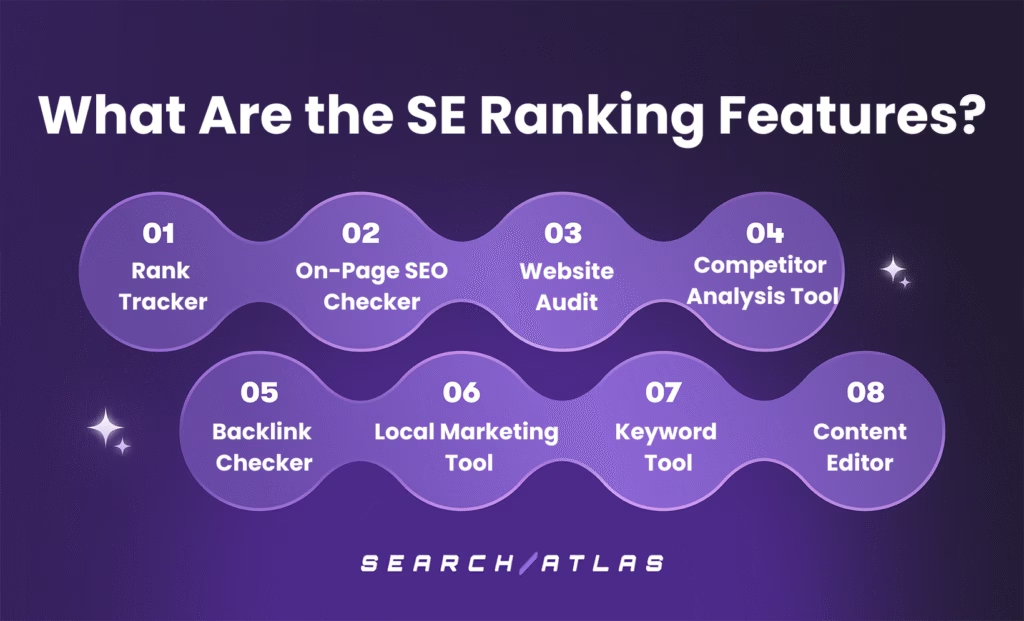
There are 8 main SE Ranking features that are designed to support SEO and digital marketing campaigns. The 8 main features of SE Ranking are listed below.
1. SE Ranking’s Rank Tracker
SE Ranking’s Rank Tracker is a tool that offers basic functionality for tracking keyword positions across various locations, devices, and search engines. SE ranking’s Rank tracker provides location-specific data and includes tracking for SERP features like featured snippets, local packs, and site links. These capabilities allow users to monitor how their content appears in different search result formats.
SE Ranking’s Rank Tracker platform supports historical data comparison, enabling users to observe ranking trends and evaluate SEO performance over time. Users can benchmark against competitors and identify fluctuations that may indicate the need for content or technical adjustments. Additionally, automatic reporting and visual analytics help streamline communication with clients or team members.
While the SE Ranking’s Rank Tracker covers the essential use cases, it may fall short in areas such as keyword segmentation, forecasting, or advanced filtering when compared to more specialized or enterprise-level platforms. Moreover, the granularity of SERP feature tracking and the frequency of updates may not be sufficient for users requiring real-time data or deeper competitive intelligence.
To use the SE Ranking’s Rank Tracker, start by creating a project and adding your website’s domain. Input the keywords you want to monitor, specify the search engines and locations, and optionally add competitor domains for comparison. SE Ranking’s Rak Tracker will then begin tracking the positions of those keywords, showing fluctuations, average positions, visibility scores, and SERP features.
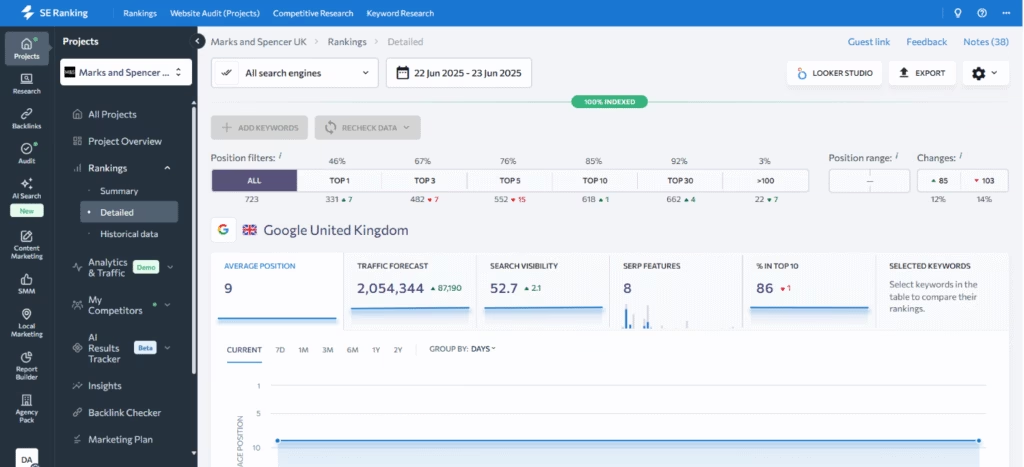
2. SE Ranking’s On-Page SEO Checker
SE Ranking’s On-Page SEO Checker is a tool built to evaluate how well a specific web page is optimized for a given keyword. SE Ranking’s On-Page SEO Checker runs an audit across various factors, including basic elements like title tags, meta descriptions, headers, keyword usage, and content length, as well as technical aspects such as page speed and mobile responsiveness. The SE Ranking’s On-Page SEO Checker Tool then assigns a score and lists recommended changes.
The key function of SE Ranking’s On-Page SEO Checker Tool is identifying specific on-page issues that could be affecting visibility in search results. The SE Ranking’s On-Page SEO Checker Dashboard highlights missing or under-optimized elements and offers side-by-side comparisons with competitor pages. While useful for quick benchmarking, the comparison may be less effective for nuanced content types or niche topics where SERP variability is high.
The SE Ranking’s On-Page SEO Checker interface consolidates all findings into one report, saving time otherwise spent on manual reviews. Additionally, SE Ranking’s On-Page SEO Checker Tool categorizes findings into actionable groups (errors, warnings, notices, or passed checks). However, some on-page SEO recommendations can be generic or lack context, particularly when dealing with more complex SEO scenarios.
To use the SE Ranking’s On-Page SEO Checker Tool, input a URL, select a search engine, country, region, depth of analysis, and Google Interface Language. Then enter the primary and secondary keywords, add the report name, and select the project group from the list or create a new one. The SE Ranking’s On-Page SEO Checker Tool will then return a report that breaks down issues by area, content, metadata, technical performance, and usability.
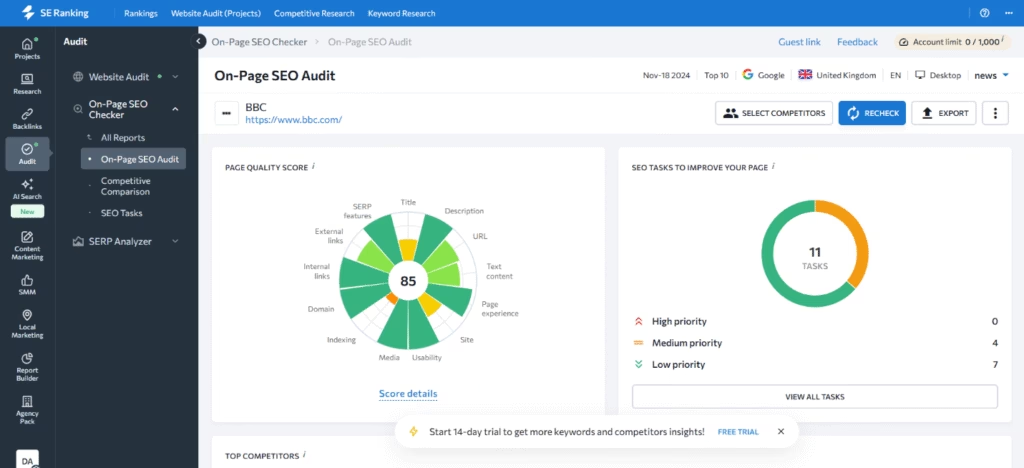
3. SE Ranking’s Website Audit
SE Ranking’s Website Audit is a tool designed to scan a website for technical and SEO-related issues that may affect its visibility and performance. SE Ranking’s Website Audit checks various factors, including crawlability, indexing, internal linking, site speed, mobile usability, HTTPS implementation, and more. After crawling the site, the SE Ranking’s Website Audit Tool provides a summary report along with a general health score.
The SE Ranking’s Website Audit dashboard identifies common problems such as broken links, duplicate content, redirect loops, and slow-loading pages. These issues are grouped and prioritized, allowing users to address the most impactful ones first. While the SE Ranking’s Website Audit dashboard is useful for surface-level diagnostics, users managing larger or more complex websites may find the depth of analysis limited compared to specialized site auditing platforms.
Each issue in the SEO site audit report comes with a brief explanation and a suggested fix. The SE Ranking’s Website Audit interface allows users to track changes over time and schedule automated audits (weekly or monthly), although customization options during scan configuration may be limited for advanced users. Moreover, some recommendations provided by the SE Ranking’s Website Audit interface can be broad or lacking in context, requiring further interpretation.
To use the SE Ranking’s Website Audit Tool, set up a project, enter the site’s domain, and configure scan parameters. Once the scan is complete, users can view findings by category, such as HTTP errors, metadata problems, or internal link issues, and export reports if needed.
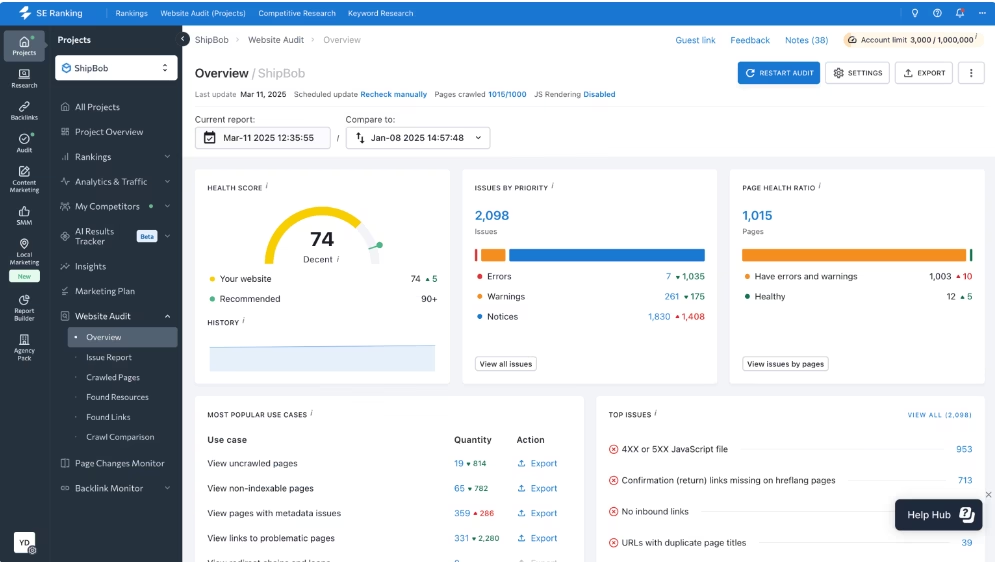
4. SE Ranking’s Competitor Analysis Tool
SE Ranking’s Competitor Analysis Tool provides data on other domains’ SEO and PPC activity, including keyword rankings, estimated traffic, backlink profiles, top pages, and paid advertising efforts. SE Ranking’s Competitor Analysis Tool is designed to give users a general overview of how competing sites are performing, with the goal of informing strategy and identifying gaps.
One of the core uses of SE Ranking’s Competitor Analysis Tool is spotting keyword and content gaps by identifying keywords competitors rank for that your site does not. While this can support content planning, the data is based on SE Ranking’s own databases, which may vary in depth and accuracy depending on region and industry. Additionally, backlink insights can help identify potential link-building targets, but detailed metrics on link quality or risk are limited compared to specialized backlink tools.
Additional features in SE Ranking’s Competitor Analysis Tool allow for examining keyword intersections, ad copy examples, and organic versus paid distribution. While this is useful for basic strategic comparisons, advanced segmentation, real-time updates, and ad performance metrics may not match those offered by more specialized platforms.
The SE Ranking’s Competitor Analysis Tool allows users to monitor competitor activity over time, such as changes in keyword rankings or traffic trends. While this is helpful for spotting shifts, the traffic estimates and campaign visibility should be interpreted cautiously, as they are modeled rather than based on direct data. Moreover, SE Ranking’s Competitor Analysis Tool includes basic visualizations to support reporting, although advanced filtering and segmentation options are limited.
To use the SE Ranking’s Competitor Analysis Tool, enter the competitor’s domain in the search field. The SE Ranking’s Competitor Analysis Tool will then provide a summary of organic and paid performance, keyword lists, top-performing pages, and referring domains.
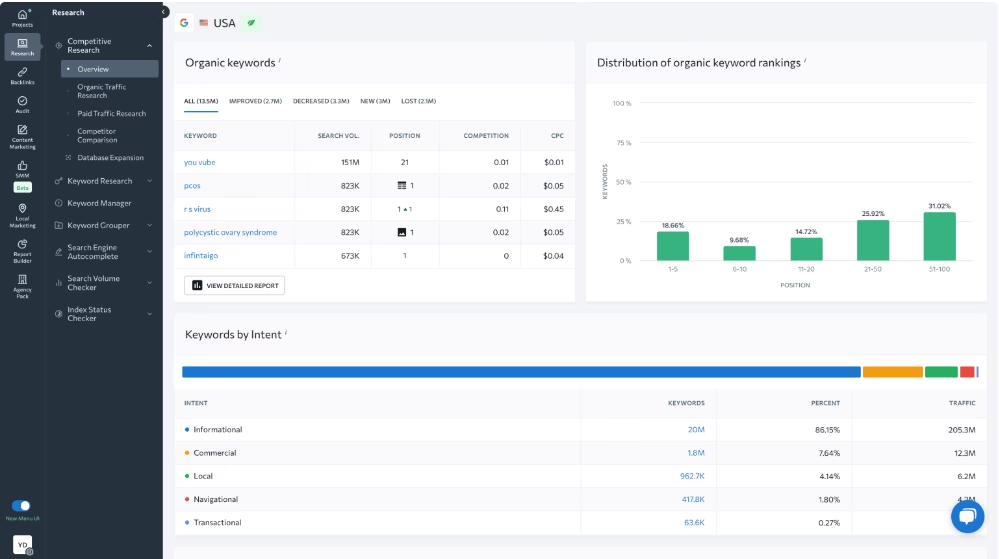
5. SE Ranking’s Backlink Checker
SE Ranking’s Backlink Checker is a tool designed to provide an overview of a domain’s backlink profile, including data on referring domains, total backlinks, anchor text usage, link types (dofollow/nofollow), and linking page quality. SE Ranking’s Backlink Checker supports both self-analysis and competitive review, giving users a general sense of how backlinks contribute to domain authority and search visibility.
The SE Ranking’s Backlink Checker Tool helps users evaluate ongoing link-building efforts and identify potential risks from low-quality or toxic backlinks. The SE Ranking’s Backlink Checker Tool highlights referring domains linked to competitors, which may serve as possible outreach targets. However, the granularity of backlink quality metrics and spam detection is limited compared to specialized link analysis platforms.
The SE Ranking’s Backlink Checker dashboard includes real-time insights and historical data, allowing users to observe trends in link acquisition, spot sudden changes, and monitor link profile development over time. While this data can help assess campaign impact or flag suspicious activity, the update frequency and scope of the backlink index may not match those of more established tools. The SE Ranking’s Backlink Checker Interface is functional for general backlink monitoring but may require supplementary platforms for in-depth link quality assessment or penalty recovery workflows.
To use the SE Ranking’s Backlink Checker Tool, enter a domain or URL into the search field. The SE Ranking’s Backlink Checker Tool will then provide a report, including metrics like referring domains, backlink count, anchor text breakdown, and country distribution.
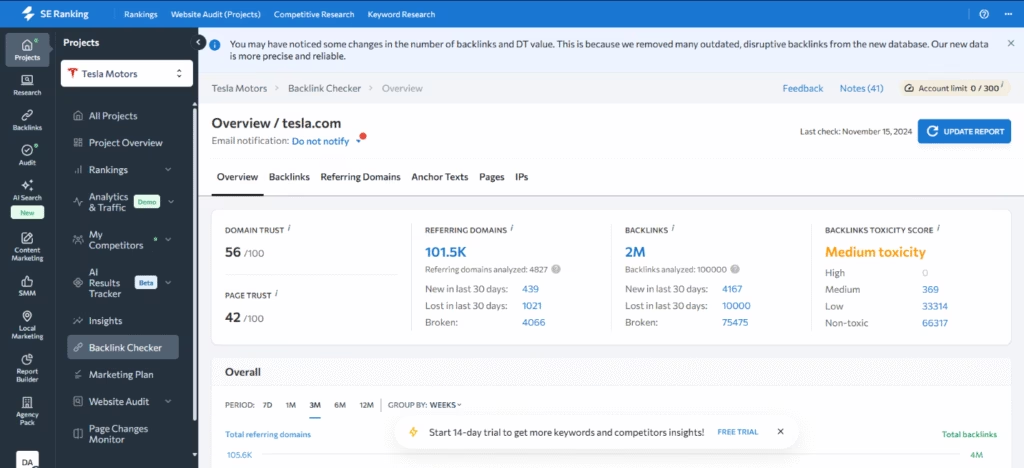
6. SE Ranking’s Local Marketing Tool
SE Ranking’s Local Marketing Tool is designed to help users monitor local search performance, manage directory listings, and track customer reviews. SE Ranking’s Local Marketing Tool aggregates data from platforms like Google Business Profile, Yelp, Facebook, and others to provide a centralized view of local SEO efforts. The SE Ranking’s Local Marketing Tool is intended for businesses with physical locations, such as restaurants, clinics, or service providers, that rely on visibility in local search results.
The main function of SE Ranking’s Local Marketing dashboard is ensuring consistency across business listings. The SE Ranking’s Local Marketing dashboard scans listings for inconsistencies in name, address, phone number, and other business details, although coverage and accuracy can vary depending on the directories involved. Additionally, users can monitor and respond to customer reviews from within the platform, but integration depth may be limited depending on the review site.
The SE Ranking’s Local Marketing interface allows for local keyword tracking by region or ZIP code, giving businesses a view of how they rank in specific geographic areas. This insight can help identify underperforming locations or opportunities to improve content targeting. However, the granularity of tracking and reporting may not match that of dedicated local SEO platforms, particularly for multi-location businesses needing more advanced segmentation.
To use the SE Ranking’s Local Marketing Tool, create or select an existing project in SE Ranking, enable the Local Marketing module, input business details, and connect listings (e.g., Google Business Profile). The SE Ranking’s Local Marketing Tool will then audit existing listings, flag inconsistencies, and begin tracking rankings for local keywords.
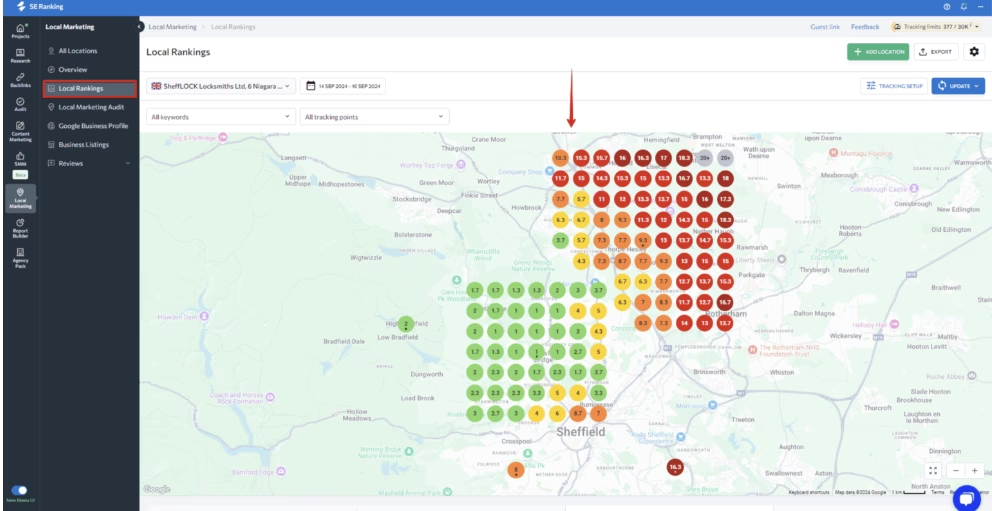
7. SE Ranking’s Keyword Tool
SE Ranking’s Keyword Tool offers basic keyword discovery and analysis capabilities for SEO and PPC planning. Users can input a seed keyword to view metrics such as search volume, keyword difficulty, CPC, competition level, and trend history. The SE Ranking’s Keyword Tool returns related queries and variations, enabling exploration of long-tail and semantically connected terms. However, content scoring and clustering features are minimal compared to dedicated content tools.
The SE Ranking’s Keyword dashboard helps identify moderately competitive, high-value keywords. However, the keyword difficulty metric is based on SE Ranking’s proprietary formula and may not align with other platforms. Additionally, CPC and competition data are provided for paid campaigns but should be considered indicative rather than definitive, as real-time bidding data is not sourced directly from ad platforms.
The SE Ranking’s Keyword Interface includes competitor keyword analysis, showing which terms rival domains rank for in both organic and paid searches. This insight supports basic benchmarking, although the keyword database size and update frequency may limit insights in certain niches or regions. The SERP analysis function provides visibility into top-ranking pages but lacks the robust SERP volatility or feature tracking found in tools more focused on real-time SEO movements.
To conduct keyword research using the SE Ranking’s Keyword Tool, enter a target keyword or phrase. The SE Ranking’s Keyword Tool will then provide an overview of metrics such as search volume, difficulty, CPC, competition, and trend data, along with similar keywords, related terms, and question-based queries.
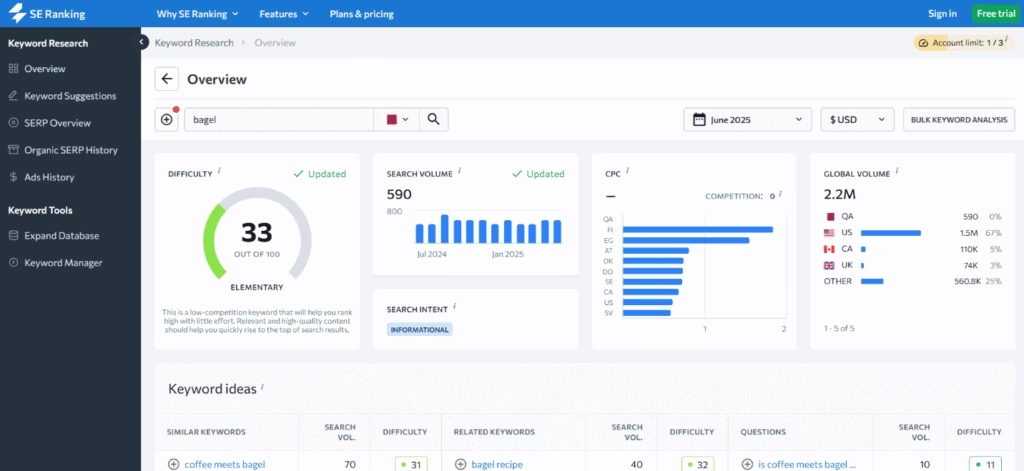
8. SE Ranking’s Content Editor
SE Ranking’s Content Editor is designed to assist users in creating content that aligns with current search engine ranking factors and user intent. SE Ranking’s Content Editor analyzes top-ranking pages for a target keyword and generates content guidelines that include recommended word count, keyword usage, structural suggestions, and readability benchmarks. The SE Ranking’s Content Editor Tool is positioned as a workflow aid for content teams aiming to streamline SEO content production within a single environment.
The Content Editor’s primary function is to help writers apply SEO principles while drafting, rather than treating optimization as a separate, post-writing task. This real-time guidance can help avoid basic keyword and formatting oversights. That said, the recommendations are largely based on surface-level SERP analysis, focusing on competitor averages for word count and keyword density. This can sometimes result in overly rigid or formulaic content if followed too closely. Moreover, the SE Ranking’s Content Editor dashboard does not currently account for deeper semantic relevance or search intent variations that often play a larger role in ranking outcomes.
The SE Ranking’s Content Editor interface supports collaborative work, allowing teams to create, edit, and monitor content through the platform. While this feature adds value for agencies or in-house SEO teams managing multiple contributors, the interface may feel limited compared to dedicated content platforms that offer multi-user permissions or publishing integrations. Additionally, the content score metric offers a general quality indicator, but it should be taken as a guideline rather than a definitive measure of ranking potential.
To use the SE Ranking’s Content Editor, create a new content task by entering your target keyword and selecting your location and language. The SE Ranking’s Content Editor will then analyze the top 10–30 ranking pages and generate a content brief with SEO recommendations. Users can write directly in the built-in editor, which updates their content score in real-time as they follow the provided guidelines.
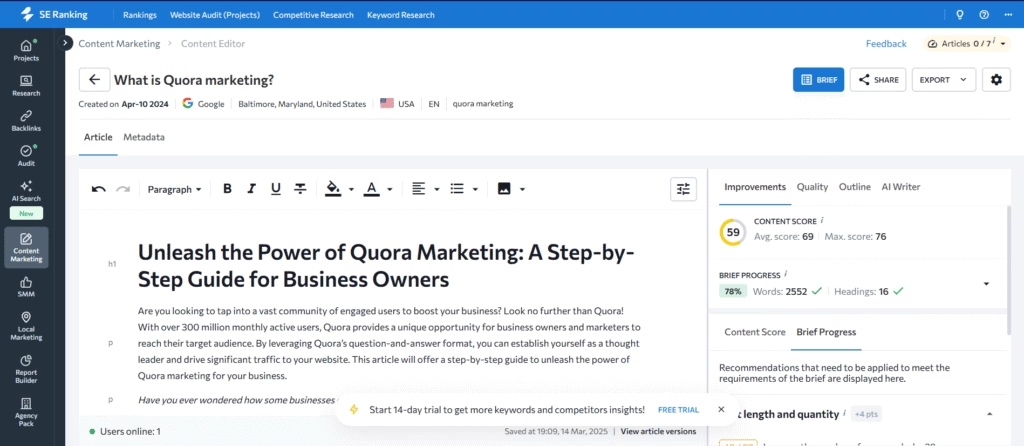
How Does SE Ranking Tool Work?
The SE Ranking Tool works by collecting, processing, and displaying SEO-related data through a cloud-based interface. The SE Ranking Tool begins automated data collection once a user sets up a project by entering their website URL, selecting target search engines and locations, and adding keywords. The SE Ranking dashboard tracks keyword rankings, audits websites for technical issues, monitors backlinks, and gathers competitor information using its own data sources and a network of global servers.
While the SE Ranking platform offers solid coverage of core SEO functions, some users may find the data granularity or depth of analysis less robust than what is available in more specialized platforms. For example, the SE Ranking dashboard’s backlink index may not match the comprehensiveness of other, more powerful tools, and real-time data refresh rates can vary depending on the pricing tier. Additionally, the SE Ranking Tool’s UI may feel limited to users looking for more advanced segmentation or customization.
How Accurate is SE Ranking Tool?
SE Ranking is generally considered accurate for monitoring keyword trends and overall SEO performance.
However, several user reviews and experiences suggest that SE Ranking’s rank-tracking data may not always reflect real-time search engine results. Users and reviews have pointed out that rankings displayed by SE Ranking can fluctuate due to personalization, device types, geographic variations, and how Google constantly updates its SERPs. In many cases, the SE Ranking Tool may show a sudden drop or spike in rankings that does not match what users see in live searches, especially for keywords outside the top 10 positions. This inconsistency makes SE Ranking less reliable for pinpoint-accurate reporting or immediate decision-making.
Moreover, a comprehensive review by Anil Agarwal noted that while SE Ranking delivers high search volume accuracy, it suggests 30-40% fewer keywords than some competitors. Additionally, the review implied that the SE Ranking platform provides limited data coverage in regions outside major markets like the USA, UK, and India. This geographical bias significantly undermines SE Ranking’s global accuracy claims.
What Pricing Plans Does SE Ranking Tool Offer?
The SE Ranking Tool offers three main pricing plans, each structured to accommodate different types of users. SE Ranking’s pricing varies depending on keyword volume, tracking frequency (daily, every 3 days, or weekly), and billing cycle (monthly vs. annual).
The SE Ranking’s Essential plan starts at around $65/month, allowing for up to 500 keyword tracking, 5 projects, and access to core SEO tools. The Essential Plan is positioned for freelancers or small businesses but comes with limitations like a single-user seat and restricted feature access.
The SE Ranking’s Pro plan starts at about $119/month and expands functionality to support up to 2,000 keyword tracking, 30 projects, 3 user seats, and additional tools such as Looker Studio integration and historical data. Additionally, the SE Ranking’s Business plan begins at roughly $259/month, offering API access, 5,000+ keyword tracking, 5 user seats, and full historical data access.
SE Ranking segments certain features as paid add-ons, like the Content Editor, Local Marketing Tool, and Agency Pack. This add-on model means the true cost can rise quickly for users who need more than basic functionality.
SE Ranking does not offer a permanent free plan but provides a 14-day free trial that gives full access to its features without requiring a credit card. This trial allows users to explore key tools like keyword tracking, site audits, and backlink analysis. Continuing to use the SE Ranking platform after the trial period requires selecting a paid plan.
SE Ranking can be worth it for those seeking an SEO platform with essential features like keyword tracking, site audits, and backlink analysis at a more affordable price than some top competitors. However, SE ranking may lack some of the advanced data depth and specialized tools offered by premium platforms. Additionally, the learning curve for maximizing SE Ranking’s AI-driven tools might require some time.
What is the SE Ranking Tool Rating?
The SE Ranking Tool receives varied ratings across software review platforms. The ratings reflect SE Ranking’s all-in-one SEO capabilities, as well as user concerns about customer support and occasional glitches. The SE Ranking reviews across major software review sites are listed below.
- Trustpilot. 3.8 / 5 (574 reviews)
- Capterra. 4.7 / 5 (285 reviews)
- G2. 4.8 / 5 (1380 reviews)
- TrustRadius. 9.4 / 10 (39 reviews)
- Gartner Peer Insights. 4.7 / 5 (35 reviews)
The ratings suggest that SE Ranking delivers functionality for users, but there are areas where the platform could improve. SE Ranking users express satisfaction with the platform’s core features. At the same time, SE Ranking users point towards issues surrounding the platform’s customer support and reliability.
What Are the Pros of SE Ranking?
There are a few pros of SE Ranking that are worth noting, although it is not as feature-heavy as some high-end SEO suites. The pros of SE Ranking are discussed below.
- Consolidated SEO Toolkit. SE Ranking offers core features like keyword tracking, backlink analysis, site audits, and competitor research within a single interface.
- Beginner-Friendly UI. SE Ranking includes a clean and easy-to-navigate dashboard, which can be helpful for those new to SEO tools. However, experienced users may find the UI somewhat simplified.
- Competitive Research Coverage. SE Ranking enables the analysis of competitors’ organic and paid traffic, keywords, and backlinks, although the depth may not match more specialized tools in certain regions.
- White-Label Reporting Options. SE ranking is useful for agencies that need to deliver branded reports for clients.
- Basic Content and AI Writing Tools. SE ranking offers a content editor with SERP-based recommendations and a lightweight AI writer. These tools are functional, but less advanced than dedicated content platforms.
- API and Third-Party Integration. API access and third-party integrations with Google Analytics, Google Search Console, and Looker Studio are available on SE Ranking, but it is only limited to Business Plans.
- Free Utilities. SE ranking offers a few lightweight tools, such as robots.txt tester and keyword volume checker, that can be used without a login.
- 14-Day Trial Access. SE ranking provides a full-featured, 14-day trial without requiring a credit card to enable users to test before committing.
The pros of SE Ranking make it a considerable choice for users looking for a reliable, user-friendly SEO toolkit. However, some users may find SE Ranking’s data coverage and advanced capabilities less robust than those of higher-tier platforms, particularly when working with large-scale or highly competitive SEO projects.
What Are the Cons of SE Ranking?
There are several cons of SE Ranking that may affect certain users, particularly those looking for advanced automation, comprehensive data sets, or seamless usability. The cons of SE Ranking are discussed below.
- Basic Backlink Database. While useful, SE Ranking’s backlink database is smaller and less comprehensive compared to top-tier SEO tools. Moreover, SE Ranking lacks some advanced backlink metrics such as a detailed spam score.
- Learning Curve for Some Tools. Advanced tools like white-label reporting or API features in SE Ranking may require time to learn.
- No Free Plan. SE Ranking only offers a 14-day free trial, and continued use requires a paid subscription.
- Local SEO and Content Tools are Paid Add-Ons. Tools like the Local Marketing module and AI-powered Content Editor in SE Ranking require additional payments on top of your subscription.
- Limited PPC Insights. While SE Ranking includes some paid keyword data, its PPC campaign analysis is less detailed compared to other comprehensive tools in the market.
- Lacks Built-In Link-Building Outreach Tool. SE Ranking does not offer integrated email outreach or prospecting features for link-building campaigns.
- Limited Third-Party Integrations. While SE Ranking integrates with major tools like Google Analytics, Looker Studio, and GSC, it lacks broader native integrations with CRMs or content platforms like HubSpot or WordPress.
- The Mobile App is Feature-Limited. SE Ranking’s mobile app allows for basic rank checking but does not offer the full suite of tools available on the desktop.
- AI Word Limits. SE Ranking’s AI writing functionality comes with word limits and does not offer unlimited word generation, unlike many dedicated AI writing tools.
- No Keyword Gap Analysis Tool. SE Ranking lacks a dedicated tool to compare your keyword profile directly against competitors to find content gaps, unlike many competitors.
- Billing Portal Is Confusing. Several SE Ranking users report that the billing section is hard to navigate and unclear when it comes to plan limits, extra charges, or managing subscriptions.
These cons of SE Ranking can add up quickly and limit its usefulness for more advanced users and for teams handling large-scale projects or needing deeper functionality.
What Do Reddit Users Think About SE Ranking?
Reddit users share mixed, but often critical, opinions about SE Ranking. Some Reddit users appreciate SE Ranking’s affordability and core features, especially for beginners or small-scale users. However, other Reddit users raise valid concerns about SE Ranking’s accuracy, performance, and long-term viability for professional-grade SEO.
A common complaint across Reddit threads is the inconsistency of SE Ranking in rank tracking and delayed data refresh rates. Reddit users note that SE Ranking occasionally lags in detecting ranking drops or changes, sometimes taking days to reflect updates that other tools surface in near real-time. This delay can be problematic for SEO practitioners who need up-to-date metrics to respond quickly. Moreover, some Reddit users question SE Ranking’s keyword difficulty scoring, citing significant discrepancies between SE Ranking and other platforms for the same search terms.


SE Ranking’s AI content tools came under scrutiny as well. Reddit users commented that the suggestions, particularly headline and paragraph generation, were not on par with dedicated writing tools. Additionally, Reddit users report that the SE Ranking’s Content Editor scoring system often requires manual adjustments, undermining its automation benefits. Other Reddit users pointed to feature gaps, like basic keyword reporting limits and challenges with local SERP tracking, which make SE Ranking less ideal for multi-client or location-specific SEO.

SE Ranking’s pricing was another pain point. Some Reddit users expressed frustration with SE Ranking’s unexpected renewal hikes and a billing structure they found opaque. A few Reddit users mentioned feeling locked into old plans due to grandfathered pricing, even if the SE Ranking tool was no longer core to their workflow.

The general consensus on Reddit is that SE Ranking delivers reasonable value for its price point, but questions remain about its reliability. Users tend to describe SE Ranking as a tool that does the job for basic SEO tasks or personal projects, but one that falls short when it comes to professional-grade use.
How Does SE Ranking Treat Its Long-term Subscribers?
SE Ranking’s treatment of its long-term subscribers has drawn criticism from several users, especially on platforms like Reddit and Trustpilot. SE Ranking users complain that loyal customers are not rewarded with price stability or meaningful upgrades. In fact, many long-term users report sudden and significant price increases upon renewal, often without any noticeable addition of new features or improvements. This approach has led to frustration among those who expected loyalty to be met with better value, not higher costs.
There is evidence that legacy or grandfathered plans are quietly phased out or downgraded, pushing SE Ranking users into more expensive tiers. Several SE Ranking users have shared that they feel trapped because leaving their current plan means losing access to their pricing, yet staying means continuing to pay more for the same or even reduced service.
Moreover, SE Ranking has faced backlash for appearing to prioritize new customers over existing loyal ones. Long-term subscribers of SE Ranking have expressed feeling neglected compared to the promotional attention and discounts given to new users, which is a common theme in user reviews and forum discussions.
While SE Ranking may offer competitive pricing for first-time users, its handling of long-term subscribers raises questions about sustainability and customer loyalty. SE Ranking’s lack of consistent loyalty incentives and unexpected price hikes may undermine customer trust over time, risking losing the core audience that supported its early growth.
How Responsive is SE Ranking’s Customer Support?
SE Ranking’s customer support receives mixed reviews regarding responsiveness and helpfulness. SE Ranking provides live chat and email support but does not offer phone-based assistance. Moreover, SE Ranking’s live chat and email support are limited to weekday business hours, which can be especially frustrating to users in different time zones.
Many SE Ranking users report that support agents take a long time to reply, even when dealing with urgent issues such as inaccurate rank tracking data or billing problems. Additionally, SE Ranking users mention that support responses felt generic or dismissive, with no real solutions offered. Some SE Ranking users say that they had to follow up multiple times just to get a basic answer, while others felt like they were being given the runaround.
Moreover, there are complaints that SE Ranking’s support is rigid when it comes to contracts and refunds. SE Ranking users report that support sticks strictly to policy and refuses to issue prorated refunds or make exceptions even when the platform fails to deliver reliable data or experiences technical issues.
How Reliable and Legit is SE Ranking as an SEO Tool?
SE Ranking is generally considered a reliable and legitimate SEO tool. However, some SE Ranking users on platforms like Reddit have raised concerns about the tool’s reliability and fairness, with a few even calling it a scam due to its business practices. Complaints often focus on SE Ranking’s unexpected price increases, rigid no-refund policies, and limited customer support. SE Ranking users feel that the platform does not treat subscribers well and lacks transparency, especially when plans change or when the service does not meet expectations. These experiences have led some to question SE Ranking’s legitimacy and overall trustworthiness.
What is the Best Alternative to SE Ranking Tool?
The best alternative to the SE Ranking Tool is the Search Atlas SEO Software Platform. The Search Atlas SEO Software Platform is a powerful, US-based SaaS company that provides comprehensive SEO tools to support marketing professionals, agencies, and businesses of all sizes. The Search Atlas SEO Software Platform delivers cost-effective, user-friendly solutions to help improve online visibility, drive traffic, and grow your digital presence.
The Search Atlas SEO Software Platform offers an innovative approach to SEO that combines advanced AI automation with traditional SEO tools. The Search Atlas SEO Software Platform delivers a complete SEO toolkit that includes robust backlink and keyword research, AI-powered content creation and optimization, on-page and technical audits, competitor monitoring, rank tracking, and outreach automation, with seamless GSC, Google Analytics, and Google Business Profile integration.
The Search Atlas SEO Software Platform’s game-changing Otto SEO Tool serves as an in-house SEO strategist, recommending tailored tasks to optimize your website, grow your keyword rankings, and improve your technical SEO health. The OTTO SEO Tool can help automate technical SEO, content optimization, and more, providing users with a dedicated AI assistant that works continuously to enhance their SEO performance without manual intervention.
The Search Atlas SEO Software Platform starts at $99 per month and offers flexible pricing plans that cater to different needs and budgets, making it a cost-effective choice for professionals and agencies of all sizes. Additionally, the Search Atlas SEO Software Platform offers white-label solutions for agencies and is trusted by 5,000+ digital marketers and agencies to optimize their workflows. With its combination of AI-powered automation, comprehensive toolset, and proven results, the Search Atlas SEO Software Platform represents the future of intelligent SEO management.
Ready to switch to a smarter, all-in-one SEO platform? Migrate from SE Ranking to Search Atlas SEO Software Platform today and unlock advanced tools for backlink analysis, AI content optimization, and outreach, without overpaying.
Are There Any Other SE Ranking Alternatives?
Yes, there are several strong alternatives to the SE Ranking Tool that cater to different SEO needs and budgets. SEO tools like the Search Atlas SEO Software Platform, Semrush, Serpstat, Ahrefs, Nightwatch, Wincher, and AccuRanker provide similar features such as keyword tracking, backlink analysis, site audits, and competitor research. All SE Ranking alternatives come with their strengths and weaknesses, so the right choice depends on your specific SEO goals and budget.
Do SEO Professionals Rank SE Ranking Among the Best SEO Tools?
No, SEO professionals generally recognize SE Ranking as a solid, budget-friendly SEO tool, but they do not consider it among the best SEO tools. Many SEO professionals appreciate SE Ranking’s all-in-one feature set and user-friendly interface. However, concerns about SE Ranking’s data accuracy, support responsiveness, and limitations in certain tools prevent it from being considered the best by most SEO professionals. Some SEO professionals prefer other SEO tools based on pricing, support, and specific use cases.








